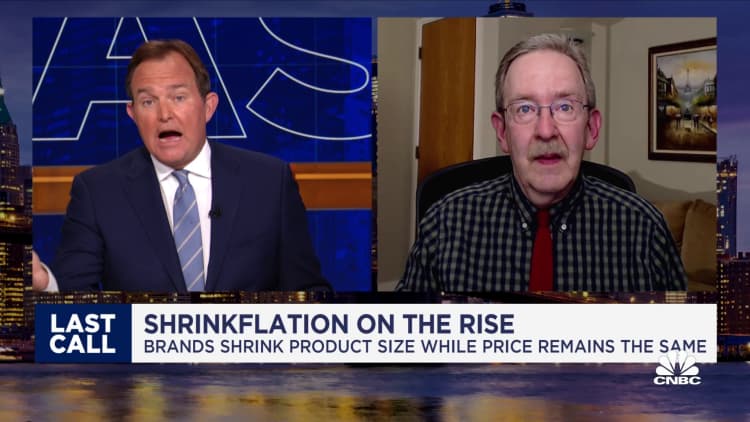Biden calls on snack makers to stop 'shrinkflation' rip-offs. Here's how to spot downsized grocery store products
[ad_1]
Anna Bizon | Gallo Images Roots Rf Collection | Getty Images
President Joe Biden took to social media ahead of the Super Bowl on Sunday to take a jab at snack companies that are giving consumers less food for their money.
The phenomenon called shrinkflation — where consumer products become smaller in quantity, size or weight while their prices stay the same or increase — is a “rip off,” Biden said.
“Some companies are trying to pull a fast one by shrinking the products little by little and hoping you won’t notice,” said Biden, who called for the companies to put a stop to the practice.
More from Personal Finance:
‘Loud budgeting’ is having a moment
Gen Z, millennials want to invest — but many aren’t
Americans can’t pay an unexpected $1,000 expense
Shrinkflation is showing up in subtle ways as sports drinks get smaller, bags of snacks have fewer chips and ice cream cartons shrink in size, Biden noted.
“The American public is tired of being played for suckers,” Biden said.
How shrinkflation, inflation are tied
The downsizing of products is nothing new and has been going on since the 1950s, according to Edgar Dworsky, a consumer lawyer and founder of the website Consumer World, who has spoken out against shrinkflation for decades.
These tactics tend to become more prevalent during times of high inflation, Dworsky said.
As prices on grocery store shelves and elsewhere have shot up, many consumers are more sensitive now to how much they are getting for their money.
Shrinkflation videos have trended on TikTok. Meanwhile, a 2022 Morning Consult poll found 64% of all adults said they are worried about it.

The president is the newest critic in Washington of shrinkflation.
In December, Sen. Bob Casey, D-Pa., spoke out against the practice with the release of a report that detailed its effects.
“This corporate greed is one of the reasons that Americans are frustrated by expensive grocery bills,” Casey said in a December statement.
Household paper products saw the biggest jump, with a 10.3% measured price increase attributable to shrinkflation, according to Casey’s report, based on data from the U.S. Bureau of Labor Statistics.
Snacks were the next category, with a 9.8% spike attributable to shrinkflation; followed by household cleaning products, 7.3%; coffee, 7.2%; and candy and chewing gum, and ice cream and related products, each with 7%.
Dworsky said he currently has a list of about nine item changes that he has been tracking since December. One of his investigations last year found consumers were getting short-changed on the number of chocolates in Valentine’s Day cardboard heart boxes.
“I’m hoping with inflation subsiding a little bit that we’ll see fewer examples, but it’s never going to go away,” Dworsky said.
How consumers can limit the effects of shrinkflation
The best approach consumers can take is to stay aware of the issue, Dworsky said.
For products you buy regularly, monitor the net weight. If a tube of toothpaste shifts from 3.9 ounces to 3.5, you may want to consider buying a competing brand that has not downsized yet, Dworsky said.
Also keep in mind that gravitating toward certain product sizes with names like “fun size” or “family size” may lead you to still buy a product out of habit even after it shrinks.
If you write a letter to the manufacturer to complain, it’s unlikely you will get them to change back to the old size, he said.
“You may get some coupons in the mail, which is always nice,” Dworsky said.
Still, Dworsky said he was thrilled when Biden’s video went live on Sunday.
“To see the president trying to educate the public about shrinkflation and to call on manufacturers to voluntarily curtail the practice, who could ask for more?” Dworsky said.
Don’t miss these stories from CNBC PRO:
[ad_2]




